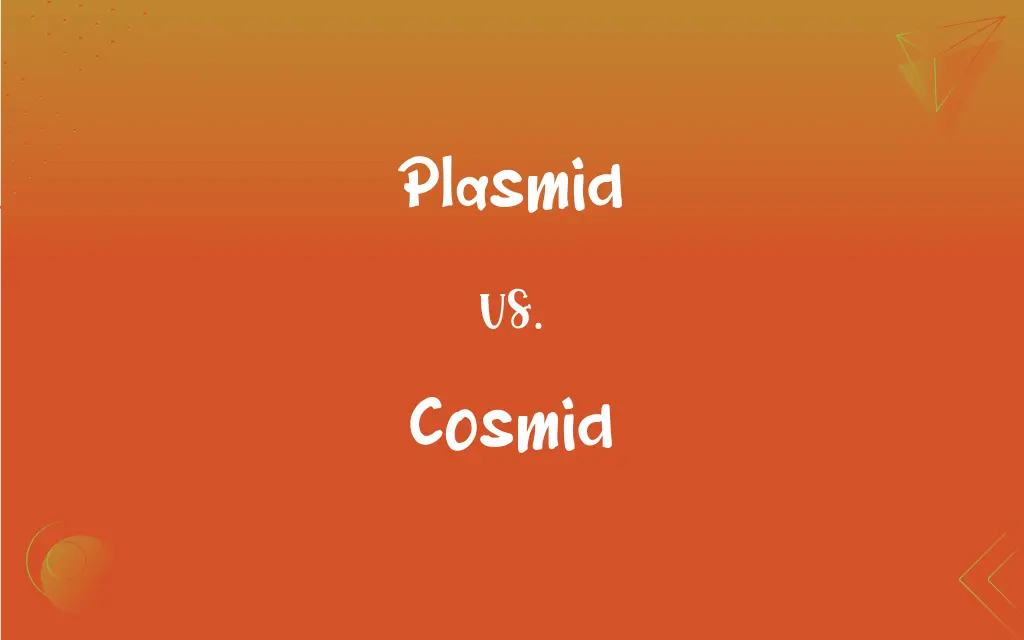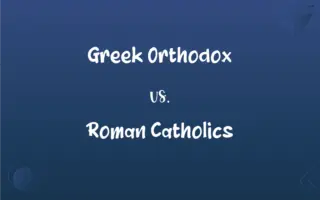Plasmid vs. Cosmid: What's the Difference?
Edited by Janet White || By Harlon Moss || Published on November 21, 2023
Plasmids are small, circular DNA molecules within bacteria; cosmids are hybrid plasmids engineered to contain cos sequences for cloning large DNA fragments.

Key Differences
A plasmid is a small, circular, double-stranded DNA molecule found in bacterial cells, independent of chromosomal DNA. In contrast, a cosmid is a type of vector, a hybrid of a plasmid and a bacteriophage lambda cos sequence, used in molecular biology for cloning.
Plasmids naturally occur in bacterial cells and sometimes in eukaryotic organisms. These molecules often carry genes beneficial to the host organism. Cosmids, however, are artificially constructed, combining features of plasmids with the lambda phage cos sequence, enabling them to carry larger DNA inserts than plasmids.
In genetic engineering, plasmids are commonly used as vectors to transfer genetic material. They are known for their ease of manipulation and replication within a host. Cosmids, with their capacity to hold larger DNA sequences (up to 45 kilobases), are particularly useful for cloning longer DNA segments.
The replication and maintenance of plasmids within a host cell depend on the specific sequences present in their DNA. Cosmids, on the other hand, replicate as plasmids but require a cos sequence for packaging into lambda phage particles, aiding in transferring large DNA fragments.
Plasmids can confer various traits, such as antibiotic resistance, to their bacterial hosts. Cosmids combine the advantages of plasmids with the high efficiency of phage infection, facilitating more complex cloning procedures involving large DNA fragments.
ADVERTISEMENT
Comparison Chart
Origin
Naturally occurring in bacteria
Artificially engineered hybrid
Size
Smaller DNA capacity
Larger DNA capacity due to lambda cos sequence
Usage
Gene transfer, cloning
Cloning large DNA fragments
Structure
Circular DNA
Circular plasmid DNA with cos sequence
Replication
Independent replication in host
Requires cos sequence for certain functions
ADVERTISEMENT
Plasmid and Cosmid Definitions
Plasmid
A tool in biotechnology for gene cloning and expression.
The researchers inserted the gene of interest into a plasmid for the study.
Cosmid
A hybrid vector used for cloning larger DNA sequences than typical plasmids can.
The cosmid was essential for the successful cloning of the lengthy DNA segment.
Plasmid
A mobile genetic element that can transfer DNA between cells.
The plasmid facilitated the transfer of genetic material between different bacterial strains.
Cosmid
An artificially constructed cloning vector that contains plasmid DNA and cos sequences of bacteriophage lambda.
They used a cosmid to clone a large DNA fragment for genomic studies.
Plasmid
A vector used in genetic engineering and research.
A plasmid was engineered to produce a protein for pharmaceutical use.
Cosmid
A tool in molecular biology combining features of plasmids and bacteriophages.
The cosmid's unique structure allowed for more efficient gene cloning in the laboratory.
Plasmid
A small, circular DNA molecule within bacteria, separate from chromosomal DNA.
Scientists used a plasmid to introduce a new gene into bacterial cells.
Cosmid
A versatile cloning vehicle with higher DNA capacity than standard plasmids.
The experiment's success depended on the cosmid's ability to handle extensive genetic material.
Plasmid
A genetic element that can replicate independently of the main chromosomes of bacteria.
The plasmid carried a gene responsible for antibiotic resistance.
Cosmid
A vector designed to carry large DNA inserts for genetic manipulation.
Researchers utilized a cosmid to insert a significant portion of the genome into host cells.
Plasmid
A circular, double-stranded unit of DNA that replicates within a cell independently of the chromosomal DNA. Plasmids are most often found in bacteria and are used in recombinant DNA research to transfer genes between cells.
Cosmid
An artificially constructed plasmid used for cloning large genes or other DNA sequences.
Plasmid
(cytology) A loop of double-stranded DNA that is separate from and replicates independently of the chromosomes, most commonly found in bacteria, but also in archaeans and eukaryotic cells, and used in genetic engineering as a vector for gene transfer.
Cosmid
(genetics) A type of plasmid (often used as a cloning vector) constructed by the insertion of cos sequences, which are DNA sequences of the lambda phage.
Plasmid
A piece of DNA, usually circular, functioning as part of the genetic material of a cell, not integrated with the chromosome and replicating independently of the chromosome, but transferred, like the chromosome, to subsequent generations of daughter cells. In bacteria, plasmids often carry the genes for antibiotic resistance; they are exploited in genetic engineering as the vehicles for introduction of extraneous DNA into cells, to alter the genetic makeup of the cell. The cells thus altered may produce desirable proteins which are extracted and used; in the case of genetically altered plant cells, the altered cells may grow into complete plants with changed properties, as for example, increased resistance to disease.
Plasmid
A small cellular inclusion consisting of a ring of DNA that is not in a chromosome but is capable of autonomous replication
FAQs
What is the typical use of a plasmid in genetic engineering?
Plasmids are used as vectors for gene cloning and expression.
Can cosmids replicate independently in a host cell?
Yes, cosmids replicate like plasmids but require a cos sequence for specific functions.
Why are cosmids used in cloning large DNA segments?
Their structure, combining plasmid and lambda phage elements, allows for handling larger DNA pieces than plasmids.
What is a plasmid?
A small, circular, self-replicating DNA molecule found in bacterial cells.
What makes plasmids important in biotechnology?
Their ability to replicate independently and transfer genes makes them key tools in genetic manipulation.
How do cosmids facilitate genetic research?
They enable cloning and analysis of large DNA sequences that are difficult with standard plasmids.
What are common traits plasmids can confer to bacteria?
Traits like antibiotic resistance, toxin production, or metabolic capabilities.
How are cosmids different from plasmids?
Cosmids are hybrid vectors containing plasmid DNA and bacteriophage lambda cos sequences, allowing for larger DNA fragment cloning.
Can plasmids carry multiple genes?
Yes, plasmids can carry multiple genes, but their size capacity is limited compared to cosmids.
Are plasmids found only in bacteria?
Primarily in bacteria, but they can also occur in some eukaryotes.
Can plasmids be used in gene therapy?
Yes, plasmids can be designed to deliver therapeutic genes to cells.
Do cosmids occur naturally?
No, they are artificially constructed for specific laboratory use.
How are plasmids isolated from bacterial cells?
Through processes like alkaline lysis or other extraction methods.
What role do cos sequences play in cosmids?
Cos sequences allow cosmids to be packaged into lambda phage particles for efficient DNA transfer.
What is the size limit for DNA inserts in cosmids?
Cosmids can typically carry DNA inserts up to 45 kilobases.
What is the role of cosmids in genome mapping?
They are valuable in cloning large DNA fragments for genome assembly and analysis.
Can plasmids be engineered for specific purposes?
Yes, plasmids can be modified for various genetic engineering applications.
How do cosmids combine the features of plasmids and phages?
They have plasmid DNA structure with the addition of phage lambda cos sequences.
How do plasmids contribute to antibiotic resistance?
By carrying and transferring genes responsible for resistance among bacterial populations.
Can cosmids be used in both prokaryotic and eukaryotic cells?
Yes, cosmids can be used in a range of cell types for genetic studies.
About Author
Written by
Harlon MossHarlon is a seasoned quality moderator and accomplished content writer for Difference Wiki. An alumnus of the prestigious University of California, he earned his degree in Computer Science. Leveraging his academic background, Harlon brings a meticulous and informed perspective to his work, ensuring content accuracy and excellence.
Edited by
Janet WhiteJanet White has been an esteemed writer and blogger for Difference Wiki. Holding a Master's degree in Science and Medical Journalism from the prestigious Boston University, she has consistently demonstrated her expertise and passion for her field. When she's not immersed in her work, Janet relishes her time exercising, delving into a good book, and cherishing moments with friends and family.








































































